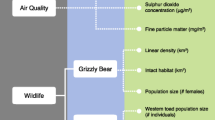Abstract
Environmental impact assessment (EIA) is a formal study process used to anticipate the environmental consequences of a proposed major development project. An EIA concentrates on problems, conflicts on natural resource constraints that could affect: (i) the viability of the project and (ii) the people, their homeland or their livelihood. After predicting potential problems, the EIA identifies measures to minimise the problems and outlines ways to improve the project’s suitability for its proposed environment. The aim of the EIA is to ensure that potential problems are foreseen and addressed at an early stage in the projects planning and design. To achieve this aim assessment’s finding are communicated to all the various groups who will make decisions about the proposed project such as project developers, investors, decision makers, regulators, planners, local community and politicians.
Access this chapter
Tax calculation will be finalised at checkout
Purchases are for personal use only
Similar content being viewed by others
References
ADB (1990). Environmental Guidelines for Selected Industrial and Power Development Projects. Office of the Environment, Asian Development Bank, Bangkok.
Ahmad, Y.J. and Swamy, G.K. (1985). Guidelines to Environmental Impact Assessment in Developing Countries. Hodder and Stoughton, London.
Ani, A.B. (2016). The Philippine Environmental Assessment Policies. FFTC Agricultural Policy Articles, Environment and Natural Resources. http://ap.fftc.agnet.org/ap_db.php?id=625&print=1. Assessed 4 March 2019.
Barrett, B.F.D. and Therivel, R. (1991). Environmental Policy and Impact Assessment in Japan. Routledge, Chapman and Hall, New York.
Dee, N., Baker, J., Drobny, N., Duke, K. and Fahringer, D. (1972). Environmental evaluation system for water resource planning (to Bureau of Reclamation, U.S. Department of Interior). Battelle Columbus Laboratory, Columbus, Ohio.
Dee, N., Baker, J., Drobny, N., Duke, K., Whitman, I. and Fahringer, D. (1973). An environmental evaluation system for water resource planning. Water Resources Res., 9(3): 523–535.
EIA (2006). Environmental Impact Assessment. Gazette of India, Extraordinary, Part-II, and Section 3, Sub-section (ii) Ministry of Environment and Forests, New Delhi.
ESSA (1994). Preliminary Design and Project Charter for ADB RETA 5544: Computerized EIA System. ESSA Technologies Ltd (report prepared for the Asian Development Bank), Manila, Philippines.
GoP (Government of Pakistan) (1997). Pakistan Environmental Protection Act. Gazette of Pakistan, Islamabad.
IUCN (1980). World Conservation Strategy: Living Resource Conservation for Sustainable Development. IUCN-UNEP-WWF.
Khadka, R.B. and Shrestha, U.S. (2011). Process and procedure of environmental impact assessment application in some countries of South Asia: A review study. J. Environ Sci. Tech., 4: 215–233.
Leopold, L.B., Clarke, F.E., Hanshaw, B.B. and Balsley, J.R. (1971). A Procedure for Evaluating Environmental Impact. Geological Survey Circular 645: Washington, U.S. Geological Survey.
McHarg, I. (1971). Design with Nature. Doubleday and Company Inc, Garden City, New York.
Ministry of Environment (1996). Environmental Protection Act (EPA). Government of Nepal.
Ministry of Environment and Forest (1997). Environmental Conservation Rules (ECR). Government of People’s Republic of Bangladesh.
Modak, P. and Biswas, A.K. (1999). Conducting Environmental Impact Assessment in Developing Countries. United Nations University Press.
Mumtaz, S. (2002). Environmental impact assessment in Bangladesh. Environ. Impact Assess. Rev., 22: 163–179.
Munn, R.E. (1979). Environmental Impact Assessment: Principles and Procedures (2nd edition). John Wiley, New York.
National Environmental Commission (2006). Reference Manual for Environmental Impact Assessment Training in Bhutan. RGB, Thimpu, Bhutan.
OECD (1992). Good Practices for Environmental Impact Assessment of Development Projects, OECD Development Assistance Committee Guidelines on Aid and Environment (1): 1–15.
Purnama, D. (2003). Reform of the EIA process in Indonesia: Improving the role of public involvement. Environ. Impact Assess. Rev., 23(4): 415–439.
Rau, J.G. and Wooten, D.C. (1980). Environmental Impact Analysis Handbook. New York: McGraw-Hill, Inc.
Sikdar, P.K., Mondal, S., Saha, L., Sarkar, S.S. and Banerjee, S. (2002). Environmental impact assessment of a proposed Info-Tech Complex in East Calcutta Wetland. The Environmentalist (now Environ. Syst. Decis.), 22(3): 241–260.
Sorenson, .C. (1971). A Framework for Identification and Control of Resource Degradation and Conflict in the Multiple Use of the Coastal Zone. University of California Berkley, Department of Landscape Architecture. M.S. Thesis. University of California Press.
UNCED (1992). Rio Declaration, United Nations Conference on Environment and Development Rio de Janeiro.
UNEP (1980). Guidelines for Assessing Industrial Environmental Impact and Environmental Criteria for the Sitting of Industry, UNEP Industry and Environment Guidelines Series 1.
Wangwongwatana, S., Daisuke Sano, D. and King, P.N. (2015). Assessing Environmental Impact Assessment (EIA) in Thailand: Implementation Challenges and Opportunities for Sustainable Development Planning. Asian Environmental Compliance and Enforcement Network (AECEN) Working Paper. Institute for Global Environmental Strategies, Hayama, Japan.
WCED (1987). Report of the World Commission on Environment and Development: Our Common Future, Oxford University Press.
World Bank (1991). Environmental assessment sourcebook: volume 2 – Sectoral Guidelines (English). World Bank Technical Paper; no. WTP 140. World Bank, Washington, DC. http://documents.worldbank.org/curated/en/415971468137388990/Environmental-assessment-sourcebook-volume-2-sectoral-guidelines.
Wood, C. (1994). Lessons from comparative experience. Built Environ., 20(4): 332–344.
Zhu, T. and Lam, K.C. (eds) (2009). Environmental Impact Assessment in China. Research Center for Strategic Environmental Assessment, Nankai University, China and Centre of Strategic Environmental Assessment for China, The Chinese University of Hong Kong.
Zubair, L. (2001). Challenges for environmental impact assessment in Sri Lanka. Environmental Impact Assessment Review, 21(5): 469–478.
Author information
Authors and Affiliations
Editor information
Editors and Affiliations
Rights and permissions
Copyright information
© 2021 Capital Publishing Company, New Delhi, India
About this chapter
Cite this chapter
Sikdar, P.K. (2021). Environmental Impact Assessment. In: Sikdar, P.K. (eds) Environmental Management: Issues and Concerns in Developing Countries. Springer, Cham. https://doi.org/10.1007/978-3-030-62529-0_12
Download citation
DOI: https://doi.org/10.1007/978-3-030-62529-0_12
Published:
Publisher Name: Springer, Cham
Print ISBN: 978-3-030-62528-3
Online ISBN: 978-3-030-62529-0
eBook Packages: Earth and Environmental ScienceEarth and Environmental Science (R0)




